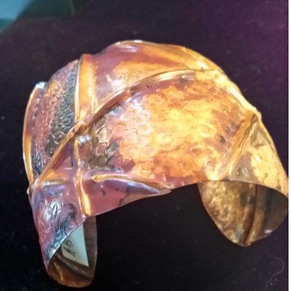A recent student inquired about the red patina on some of my class samples so I sent her some info and thought I'd share it with all.
The red is what I call "Burned Flux Patina". It only works on copper.:
You glob on white paste flux. Some thick areas, some thin and some no flux. Heat to dry then continue to heat with torch til RED hot. It has to be heated to glowing RED hot and quenched immediately. Quenching it in boiling water, Boiling salt water, or just plain water seems to create different colors of red. Experiment. ( I think the boiling aspect helps the reds develop as quench takes longer to cool)
Where the flux was thick, you retain a clean copper look, where it is thin a red and where none it is often black. Never pickle it, To dissolve the flux residue soak in hot water. The problem is the hot quench stresses the metal and anneals it so it is pretty soft. The reds are durable, sometimes you can polish off the black and see red under it. This is not the same as when you wave a torch over the copper to create colors. Having control for an even color is almost impossible, so embrace the mottled look. If you hate what you got....add more globs of flux and try again. If you get blues or greens, that is probably flux glass residue and will come off if soaked in hot water. Sometimes you can use leather or nylon mallet to stiffen metal up a bit and not harm the color. A clear coat or a wax finish usually brings out a bit of richness to the color and gives it a bit of protection from wear but, as I said, this is a very durable finish. I polish off areas of it with a fine blue silicone rubber wheel when I want to highlight an area Give it a whirl and comment here to let us know what you discovered.
You glob on white paste flux. Some thick areas, some thin and some no flux. Heat to dry then continue to heat with torch til RED hot. It has to be heated to glowing RED hot and quenched immediately. Quenching it in boiling water, Boiling salt water, or just plain water seems to create different colors of red. Experiment. ( I think the boiling aspect helps the reds develop as quench takes longer to cool)
Where the flux was thick, you retain a clean copper look, where it is thin a red and where none it is often black. Never pickle it, To dissolve the flux residue soak in hot water. The problem is the hot quench stresses the metal and anneals it so it is pretty soft. The reds are durable, sometimes you can polish off the black and see red under it. This is not the same as when you wave a torch over the copper to create colors. Having control for an even color is almost impossible, so embrace the mottled look. If you hate what you got....add more globs of flux and try again. If you get blues or greens, that is probably flux glass residue and will come off if soaked in hot water. Sometimes you can use leather or nylon mallet to stiffen metal up a bit and not harm the color. A clear coat or a wax finish usually brings out a bit of richness to the color and gives it a bit of protection from wear but, as I said, this is a very durable finish. I polish off areas of it with a fine blue silicone rubber wheel when I want to highlight an area Give it a whirl and comment here to let us know what you discovered.


 RSS Feed
RSS Feed
